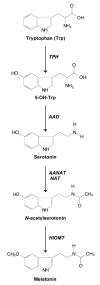Differential effects of melatonin as a broad range UV-damage preventive dermato-endocrine regulator
- PMID: 21519406
- PMCID: PMC3051850
- DOI: 10.4161/derm.3.1.14842
Differential effects of melatonin as a broad range UV-damage preventive dermato-endocrine regulator
Abstract
Melatonin or N-acetyl-5-methoxytryptamine, is a compound derived from tryptophan that is found in all organisms from single cells to vertebrates and the human. It is one of the most evolutionarily conserved and pleiotropic hormone still active in humans and has been implicated in vital skin functions such as hair growth, fur pigmentation as well as melanoma control. Being a main secretory product of the pineal gland, melatonin regulates seasonal biorhythms, reproductive mechanisms or mammary gland metabolism. Due to its wide range endocrine properties it is also recognized to modulate numerous additional functions ranging from scavenging free radicals, immunomodulation-mediated DNA repair, wound healing, involvement in gene expression connected with circadian clocks and modulation of secondary endocrine signaling including prolactin release. Recently, apart from above mentioned entities, it was shown that melatonin suppresses ultraviolet (UV)-induced damage in human skin and human derived cell lines (e.g., keratinocytes, fibroblasts). The magnitude of UV-induced damage is mediated apparently by various molecular mechanisms related to generation of reactive oxygen species (ROS), apoptosis and mitochondrial-mediated cell death which are all counteracted or modulated by melatonin. We provide here an update of the relevant protective effects and molecular mechanisms of action of melatonin in the skin.
Keywords: antioxidant; apoptosis; melatonin; mitochondria; oxidative stress; skin; ultraviolet radiation.
Figures


References
-
- Lerner AB, Case JD, Takahashi Y, Lee TH, Mori W. Isolation of melatonin, a pineal factor that lightens melanocytes. J Am Chem Soc. 1958;80:2587.
-
- Fischer TW, Slominski A, Zmijewski MA, Reiter RJ, Paus R. Melatonin as a major skin protectant: from free radical scavenging to DNA damage repair. Exp Dermatol. 2008;17:713–730. - PubMed
-
- Rato AG, Pedrero JG, Martinez MA, del Rio B, Lazo PS, Ramos S. Melatonin blocks the activation of estrogen receptor for DNA binding. FASEB J. 1999;13:857–868. - PubMed
-
- Guerrero JM, Reiter RJ. Melatonin-immune system relationships. Curr Top Med Chem. 2002;2:167–169. - PubMed
LinkOut - more resources
Full Text Sources
Other Literature Sources
